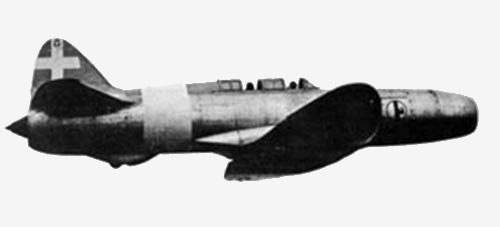Caproni Campini N.1
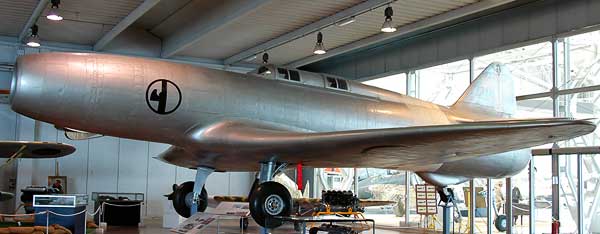
In 1939 inventor Secondo Campini convinced the Caproni company to build an airframe to test his new power unit, which he believed would replace the propeller. The Italian aircraft industry had decided that a gas turbine engine was impractical (even as German and British scientists were testing theirs). The Caproni Campini N.1 flew in 1940 and has sometimes been touted as the world's first jet aircraft. It was nothing of the sort - power came from a relatively small piston engine inside the forward fuselage, which turned a variable-pitch compressor in what we would today call a ducted fan. A rudimentary form of afterburner allowed fuel to be burned in a propelling nozzle to give some extra thrust. Despite this, the N.1 would only make 233mph, slower than the Fiat CR.42 biplane.
The N.1 completed a number of test flights. On 30 November 1941, test pilot Mario de Bernardi flew the aircraft from Milan to Rome carrying a consignment of mailbags, landing at Pisa to refuel and completing the 168-mile flight at an average speed of 130mph, which was hardly a spectacular feat. Further flight testing was carried out by the Italian Air Force (Regia Aeronautica) at the Guidonia Research Establishment. It was later taken to England, and scrapped after evaluation.
Caproni Campini N.1 - From Wikipedia
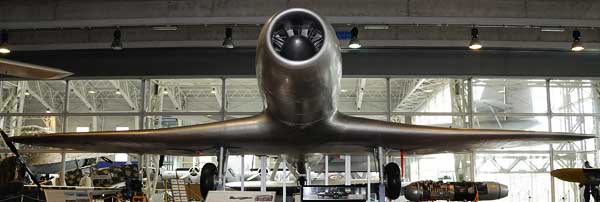
The Caproni Campini N.1 (sometimes incorrectly referred to as the CC.2) was an early motorjet-powered test aircraft.
Design and development
In 1931 Italian engineer Secondo Campini submitted a report on the potential of jet propulsion to the Regia Aeronautica, and the following year, demonstrated a jet-powered boat in Venice. In 1934, the Regia Aeronautica granted approval for the development of a jet aircraft to demonstrate the principle.
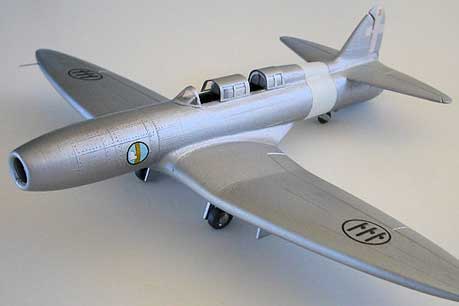 |
A nice clear photo of the Caproni Campini N1 as a plastic model |
As designed by Campini, the aircraft did not have a jet engine in the sense that we know them today. Rather, a conventional 670 hp Isotta Fraschini L. 121/R.C. 40 piston engine was used to drive a compressor, which forced compressed air into a combustion chamber where it was mixed with fuel and ignited. The exhaust produced by this combustion was to drive the aircraft forward. Campini called this configuration a "thermojet," but the term "motorjet" is in common usage today since thermojet is now used to refer to a particular type of pulsejet (an unrelated form of jet engine). It has also been described as a ducted fan.
The Italian aircraft designer Luigi Stipa (1900-1992) contended that his Stipa-Caproni experimental aircraft, a ducted-fan design of 1932, was the first aircraft to employ what he called an "intubed propeller" -- essentially the motorjet principle -- and that he therefore deserves the credit for the invention of the jet engine. The Caproni-Campini N.1 did employ many of the principles first tested in the Stipa-Caproni aircraft, albeit in a more advanced form.
Operational history
Campini turned to the Caproni aircraft factory to help build the prototypes, and two aircraft and a non-flying ground testbed were eventually constructed. The first flight was on 27 August 1940 with test pilot Mario De Bernardi at the controls.
Great propaganda use was made of the aircraft by Benito Mussolini and the Federation Aeronautique Internationale recognized this at the time as the first successful flight by a jet aeroplane.
Following World War II, one of the prototypes was shipped to the United Kingdom for study at the Royal Aircraft Establishment at Farnborough.
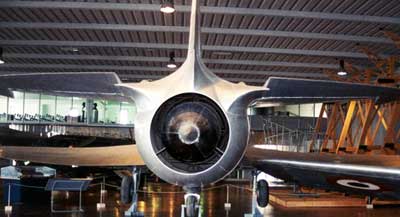
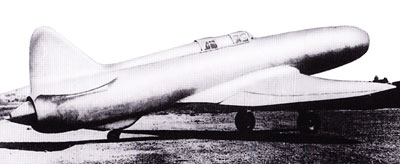 |
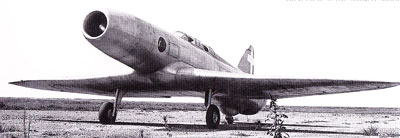 |
Specifications for the Caproni Campini N.1
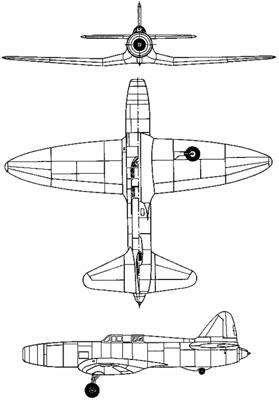 |
Crew: 2 Performance |
 |
||
| A: The N.1's power system had no hot compressor section. The cold compressed air was ducted and mixed with jet fuel and ignited, giving extra thrust. | B: Two prototypes of the N.1 were built, the second being preserved at the Museo Storico dell'Aeronautica, Vigna di Valle, north of Rome. | C: A more powerful supercharged engine might have made a difference to the N.1's pedestrian performance, but wartime pressures brought an end to development. |
| D: The low power of the N.1's piston engine kept it below 13,124 ft, where the ducted fan arrangement would have been effective. | E: The wing was mounted as low as possible and the cockpit as high as possible to give the N.1 the most straight airflow to the deeply buried engine. | F: Use of the afterburner massively increased the fuel flow, but only added an extra 25 mph to the top speed of the N.1. |
Notes from FG Researcher Johan Visschedijk
What I learned today is that the Caproni-Campini had the project designation N.1 and there were two prototypes in this project, designated:
- Caproni-Campini C.C.1 (single seat, c/n 4849, Italian AF serial MM487)
- Caproni-Campini C.C.2 (two-seat, c/n 4850, Italian AF serial MM488)
The designations confusion/mix-up in many publications is triggered by the first flight of the type, as it was the second prototype C.C.2 that first flew on August 28, 1940.
Hence the C.C.2 was heralded in many propaganda publications as the first jet-powered aircraft.
The second single-seat prototype C.C.1 first flew on April 11, 1941. Jane’s 1941 C.C.2 was bigger, however, I’m unable to find photographic proof nor any size details. Jane’s didn’t state the date of the first flight. I guess that in wartime getting the information correct was no certainty.
The information above comes from a number of sources including the Italian version of Wikipedia. No, I don’t speak Italian, but used Google translate J, and by the detailed sources listed (including Georgio Apostolo) I believe this is fairly accurate.
Cheers, Johan


